Want to learn how to make cold brew coffee at home? Here are 3 super easy recipes (mason jar, french press, Toddy). I also include ratios, benefits, and tips for making cold brew coffee.
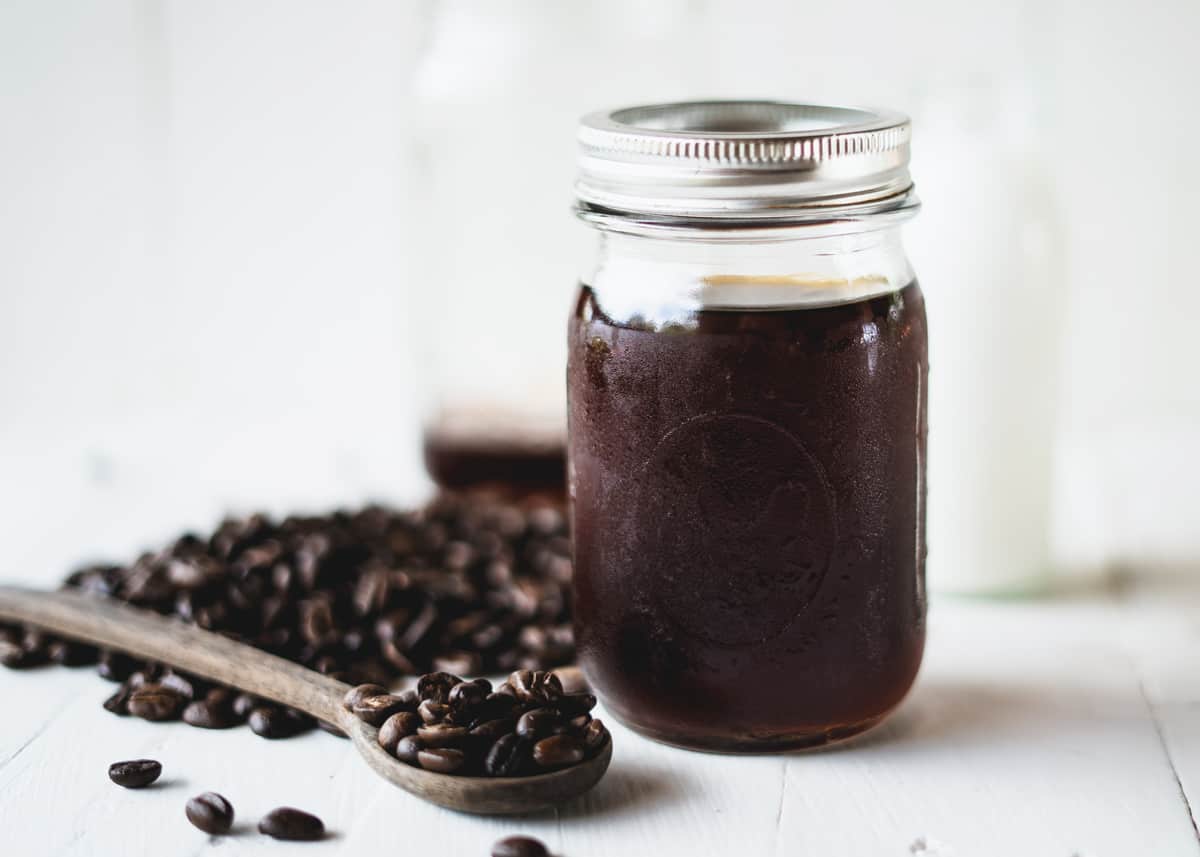
Table of Contents
How to Make Cold Brew Coffee (Complete Guide)
You may have noticed that cold brew coffee usually costs more than iced coffee at your local cafe. That may be because it’s more time consuming to make and/or because it’s considered a superior brew method.
Why do cold brew lovers think its superior to regular coffee? We’ll start the post off by talking about that, and for all my fellow coffee geeks out there – it’s pretty interesting.
First, let’s talk about how cold brew coffee is different than iced coffee.
Cold Brew vs Iced Coffee
So is cold brew just another type of iced coffee? It may seem that way because it’s often served with ice, but cold brew has a different brew method and chemical profile than iced coffee.
- Cold brew coffee is brewed/steeped with cold or room temperature water. And it has a much longer brew time. It often has a different flavor/chemical profile because some of the acids and oils (the compounds that can add bitterness) in coffee are not soluble in cold water, but the sweeter compounds are. That means that cold brew can have a sweeter flavor and be easier on sensitive stomachs. It can also be a good option for people trying to cut down on sugar because it may not require as much sugar as iced coffee.
- Iced coffee is brewed with hot water which is then cooled by adding ice. The coffee used for iced coffee could have been brewed in a number of ways (drip machine, french press, AeroPress…) and may have a slightly bitter flavor depending on how long the brewing process took. It may also develop a bitter flavor if it is allowed to cool at room temperature before adding the ice. This is why many of us like to add more sugar and cream/milk to iced coffee.
That’s just a quick breakdown of some of the differences, we’ll get into more of the specifics as we go through the post. Let’s start off by looking at what makes cold brew coffee special.
How does iced coffee compare to cold brew? See the differences in our new guide Cold Brew vs Iced Coffee

What is Cold Brew Coffee?
There is a lot of buzz about cold brew and with good reason – it’s delicious.
But what’s different about it? Let’s talk about some of the differences and then we’ll get into the specifics about how to make cold brew coffee at home.
If I miss a question you’ve had on your mind, please let me know in the comments at the end of the post and I’ll do my best to answer it.
Is Cold Brew Coffee Stronger than Regular Coffee?
The cold brew steeping process does produce a more concentrated coffee than regular hot brew because you use a higher ratio of coffee grounds to water.
But it is less acidic (thanks to the cold water steeping) and because it is usually diluted 50/50 with water it results in a smoother more gentle coffee.
With that being said, if you just drink cold brew as is (without diluting) it would be stronger than a regular cup of coffee. But hot brewed coffee is more often referred to as strong coffee.
Does Cold Brew Have More Caffeine than Regular Coffee?
No, not usually. But it depends on how it’s served and the mix ratio.
- Caffeine is one of the compounds in coffee that is more soluble in hot water. So while cold brew does produce a concentrated form of coffee, it’s brewed by steeping ground coffee in cold water.
- And when it’s served, cold brew is usually diluted (with water and milk/cream). As a result, a cup of cold-brew coffee usually contains less caffeine than a regular cup of hot-brewed coffee.
If you do not dilute cold brew when you drink it, then it would have more caffeine than the same amount of hot brewed regular coffee because it is a concentrate.
What is Cold Brew Concentrate?
Cold brew concentrate is the concentrated coffee produced when you steep a higher-than-normal ratio (usually a 1:4 ratio) of ground coffee to water in cold water for 12 to 24 hours.
The cold brew concentrate is usually diluted 50/50 with water (and often some milk/cream) before being served.

7 Benefits of Cold Brew Coffee
Why do people choose cold brew over regular coffee or iced coffee? There could be a number of reasons.
- Flavor: Cold brew coffee has a different chemical profile than regular coffee. Some of the compounds that can produce a bitter flavor when coffee is brewed with hot water are less soluble in cold water so cold brew is less likely to taste bitter. But the compounds that can give coffee sweet flavor notes remain soluble in cold water. That means people who like sweeter flavors in their coffee are usually cold brew coffee fans.
- Less acid: Cold brew is less acidic than regular coffee so many people with sensitive stomachs find it less upsetting. A cold brew can contain up to 60% to 70% less acid than regular coffee (unless the cold brew concentrate has not been diluted).
- Sweeter: It also has sweeter flavor notes so people trying to cut down on sugar may find it a better option than regular coffee because they may not need to add as much sugar or none at all.
- Less caffeine: Cold brew is usually diluted (1:1) with water, milk, and/or cream when served so it has less caffeine than regular coffee. This could make a difference for people sensitive to caffeine. But it still has a nice amount so it’s not like a decaf option. It just contains less than regular coffee.
- Bean practicality: Cold brew can be a way to still get the good out of older coffee beans. Because it has a long steep time, the flavors left in the beans will be extracted differently than with a regular hot brew process, you may get more flavor out of them. And if you like the flavor of a light roast but find it more acidic than a darker roast – cold brew may be your answer to using up those light roast beans. Light roasts often produce fruity/citrus flavor notes and I love that in a cold brew.
- It’s already cold: That might sound funny but when you’re making iced coffee it’s ideal to start out with cold brew because it’s already cold which means your ice will last longer. You also won’t have to worry about the bitter flavors that sometimes come from making iced coffee from hot brewed coffee.
- You don’t have to brew it daily. Once the 12 to 24-hour steeping process is over you can store your cold brew coffee in the fridge for up to two weeks, as long as it is sealed properly. It maintains its flavor much better than storing hot brewed coffee because it’s a concentrate. That means your morning coffee routine just got a lot quicker.
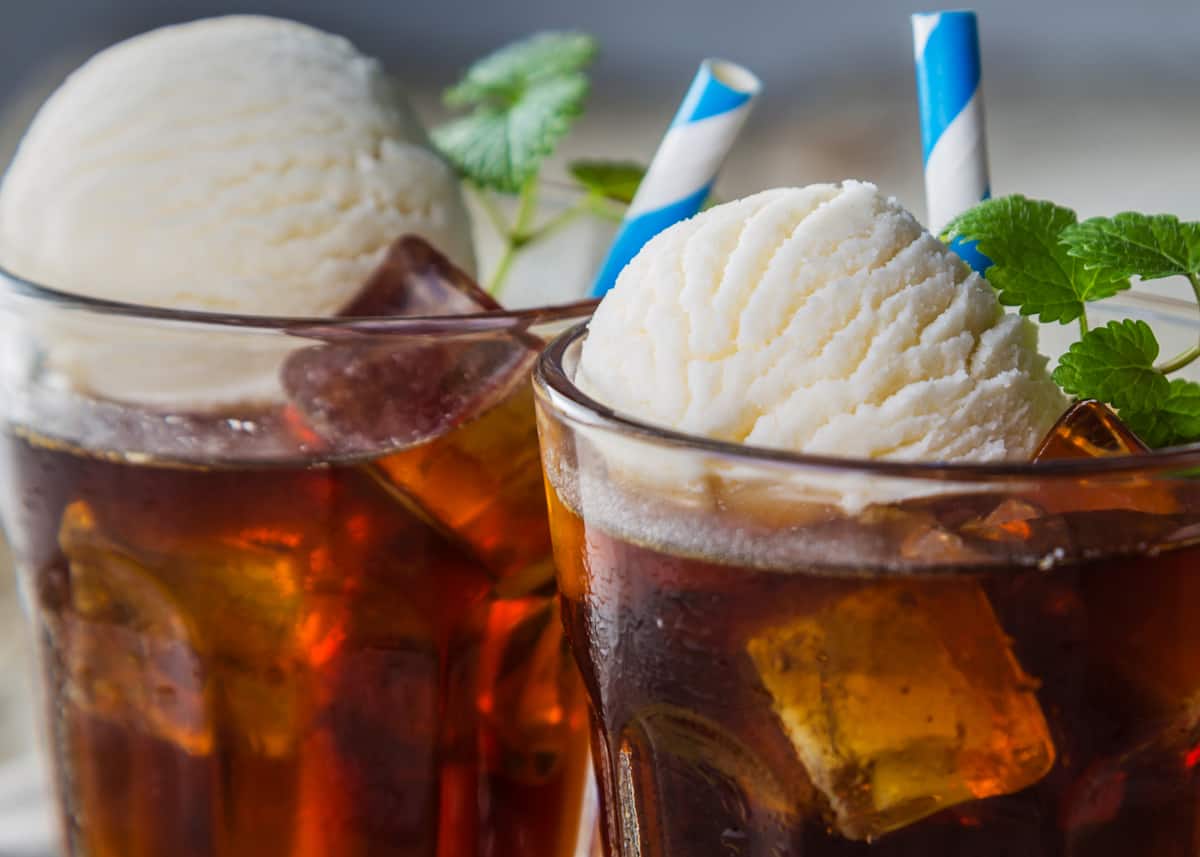
Is Cold Brew Coffee Easier on Your Stomach?
For many people, the answer is yes. Because the cold brew coffee process produces a less acidic coffee which is lower in caffeine (when diluted 1:1 with water) it can be easier on your stomach.
- Acidic food and drink cause stomach problems for a lot of people and coffee is often problematic. But many cold brew lovers have found that it’s less bothersome than regular coffee. This is because the acidic compounds in coffee are less soluble in cold water. And on top of that cold brew is usually served diluted 50/50 with water. That all means less acid in your cup and your tummy. Often cold brew coffee can contain as much as 60% to 70% less acid than regular coffee. This depends on how it is served, so it’s good to ask if the cold brew concentrate has been diluted if you’re not making it yourself.
- Caffeine also causes stomach problems for those with sensitivities. This is another compound that is less soluble in cold water, so as with the acid, the caffeine is reduced in diluted cold brew beverages.
With the lower acid and caffeine levels, some people notice that acid reflux improves as well.
If you’re a coffee lover with a sensitive stomach you might want to give making cold brew at home a try and see if you notice a difference. If you’re not in the mood for drinking coffee cold (especially on cold days) you could try diluting your cold brew with hot water to warm it up.
If you experiment with could brew after reading this post let me know how it goes by leaving a comment in the comment section.
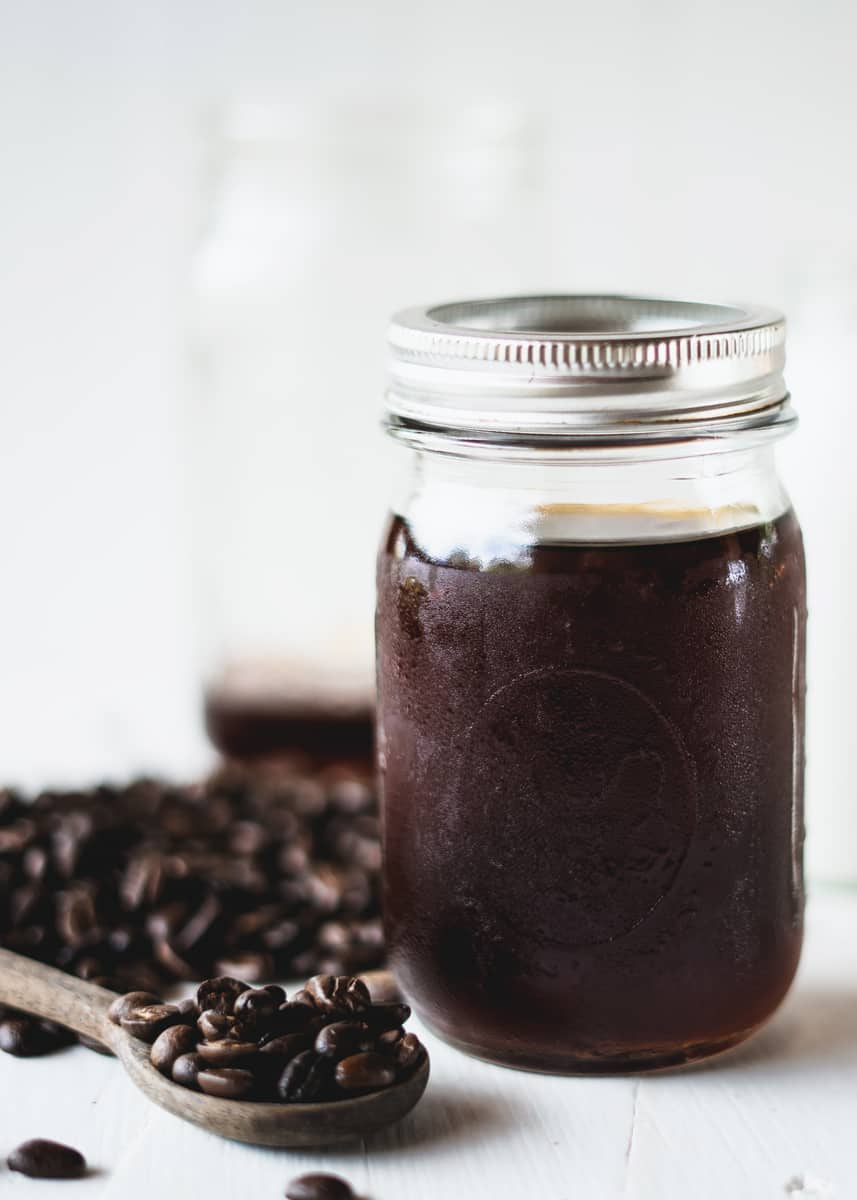
Here’s how to choose the best coffee beans for cold brew (plus our 4 recommendations).
How to Make Cold Brew Coffee at Home
Although cold brew coffee is often more expensive than regular coffee (when you order it at a cafe/restaurant) it isn’t hard to make. So learning how to make cold brew coffee at home is pretty easy. Good news right?!
The biggest consideration here is time. You’ll need to plan ahead at least 12 to 24 hours to make a true cold brew.
Want more good news? You don’t even need special equipment to make your cold brew. You’ve probably already got what you need, and if not you won’t need to spend very much to get set up, probably less than $10.00.
When it comes to making cold brew it helps to remember that while you can drink it cold you don’t have to. You can enjoy it both ways:
- As Iced Coffee: Cold brew coffee is often served as iced coffee, it’s diluted with cold water and then served over ice. You can add whatever you like to your cold brew iced coffee.
- As Hot Coffee: Cold brew can also be enjoyed as a hot beverage. Just dilute with hot water rather than cold. You could also use warm milk/cream to make a richer “hot cold brew”.
Helpful tip: Use a liquid sugar sweetener when drinking cold brew coffee cold because it will dissolve easily in cold liquid. A great way to do that is to mix up some “sugar water” by dissolving sugar into boiling water, just keep the ratio equal. For example 1/4 cup sugar into 1/4 cup of water. Let it cool and store it in the fridge until you need it.
If you can’t or don’t want to use sugar learn about alternatives for sweetening coffee.
Let’s jump right into the nitty-gritty of cold brew coffee now, the ratio of coffee grounds to water.
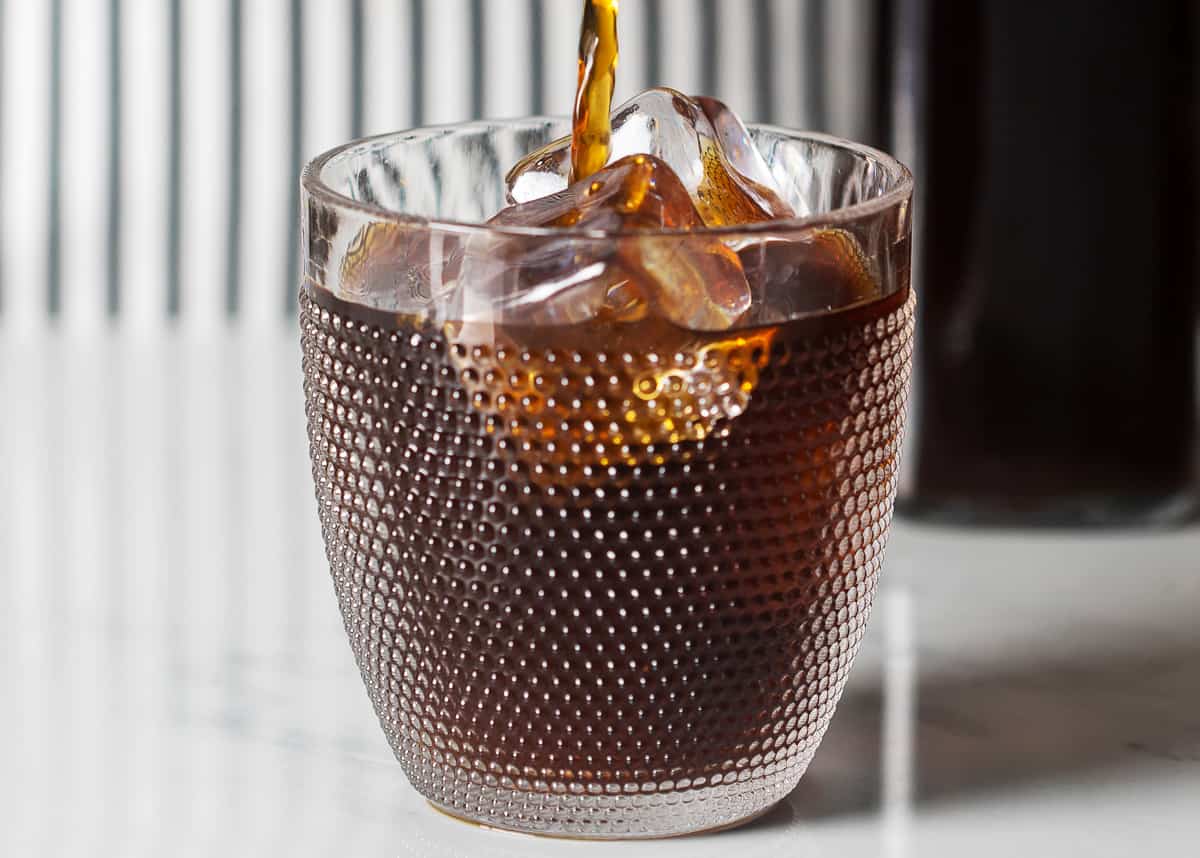
Cold Brew Coffee Ratio
What is the best coffee-to-water ratio for making cold brew? There are a lot of opinions out there, and again experimentation is the key for finding out what you like best.
Cold Brew Coffee Ratio: For me a ratio of around 1:4 or 1:5 works best. For example one cup of coffee grounds to 4 cups of water. I don’t weigh my ingredients, measuring cup for cup works just fine.
That’s a lot of coffee grounds right?! Yes, it is, and that’s why cold brew is called concentrate. After brewing (steeping) it’s usually diluted 1:1 or 1:2 with water or milk. Because it’s a concentrate it holds its flavor very well and results in a smooth delicious coffee.
If you don’t want such a concentrated cold brew coffee you can use a different brew ratio. Try a 1:7 or a 1:8 ratio.
How Long Should I Brew (Steep) Cold Brew Coffee?
It may depend on where you’re steeping your cold brew. But it’s usually best to go more than 12 hours regardless of if you’re steeping on the counter or in the fridge. That way the flavors have a chance to develop.
- On the counter: According to the experts over at Stumptown Coffee Roasters if you’re steeping at room temperature it might be best to go with between 14-18 hours. If you leave it steeping longer it could take on some unpleasant flavor notes. When you’re done it’s best to put it in the fridge as soon as possible.
- In the fridge: If you’re steeping in the fridge you can leave it a little longer, around 20-24 hours.
With that being said it’s fun to experiment because different beans will have different flavor notes, and different roasts (light, medium, dark) will also affect the flavor of your cold brew.
You may find that steeping your coffee a little longer (or a little less) will produce a better (or worse) cold brew. It’s always good to experiment, and you may be pleasantly surprised.
What Size Grind Should I Use for Cold Brew Coffee?
For cold-brew coffee, a coarse grind works best. And it’s easier to strain out.
If you’ve got a medium grind that should work as well, just keep in mind you may need to use a different strainer than with a coarse grind, perhaps a paper strainer.
Finding the right coffee grinder can help when it comes to making cold brew coffee, a burr grinder with a few different settings in the coarse grind range would be great, most of them offer just that.
How Long Can I Store Cold Brew Coffee?
When properly sealed cold brew coffee can be stored for two weeks in the fridge. Just make sure you store your coffee properly which means covering it well to keep out flavors or aromas that may be floating around in your fridge.

3 Cold Brew Coffee Recipes
Now that we’ve talked about the ratio of grounds to water, the brew time and the grind size let’s talk about how you can make cold brew coffee at home.
There are a lot of cold brew coffee makers out there and I’ll be writing an in-depth post on them in the future. But for now, let’s take a look at a few of the most popular ways to make it.
- Mason jar cold brew coffee
- French press cold brew coffee
- Toddy system cold brew coffee
1. How to Make Cold Brew with a Mason Jar
Making cold brew coffee with a mason jar is popular because most people already have one in their cupboard or pantry – and it’s easy.
Mason Jar Cold Brew Coffee Recipe
How to make cold brew coffee with a mason jar:
- Measure out your medium to coarse grounds at a 1:4 or 1:5 coffee-to-water ratio in your mason jar. For example 1 cup of ground coffee to 4 cups of filtered cold or room temperature water.
- Stir the coffee in the water making sure they are thoroughly wet. Or you could put the cover on and invert it a few times.
- Set to brew. Put the lid on the mason jar or cover it with plastic wrap (or something else to protect it from bugs and flavors/aromas) and set it in the fridge for 12 to 24 hours. Or if you don’t have space in the fridge you can leave it on the counter for between 14-18 hours.
- Strain. When it’s ready, remove the lid and strain the grounds through a cheesecloth (or a similar method). See tips below.
- Enjoy! Pour the concentrate into another container, cover it, and store it in the fridge. This concentrate can be served diluted in equal parts with water or milk, but that’s just a suggestion, experiment and see how you like it best.
Helpful tips: You can use a pour-over coffee maker or a Chemex with a paper filter, to strain out the grounds.
You could also use one of the options mentioned below in the video which can cut down on mess and save you a few minutes because they come with stainless steel filters so there’s no need to strain.
The following video will give you an idea of how easy it is to make cold brew coffee at home with a mason jar:
If you have a mason jar at home you can get started, but it you don’t or you want to try an even easier method check out these two options:

This Mason Jar Cold Brew Coffee Maker (Amazon or MasonJars.com) is a popular choice. It comes with a stainless steel filter and lid so you don’t have that potentially messy straining process.
You just put the grounds in the filter and let them steep, remove the filter and put the mason jar back in the fridge.
This Airtight Cold Brew Coffee Maker (Amazon or Newegg) is a similar design and is also airtight (which is always a good thing when it comes to storing coffee) and it has a handle
The lid and filter are stainless steel and the glass is extra-thick borosilicate.
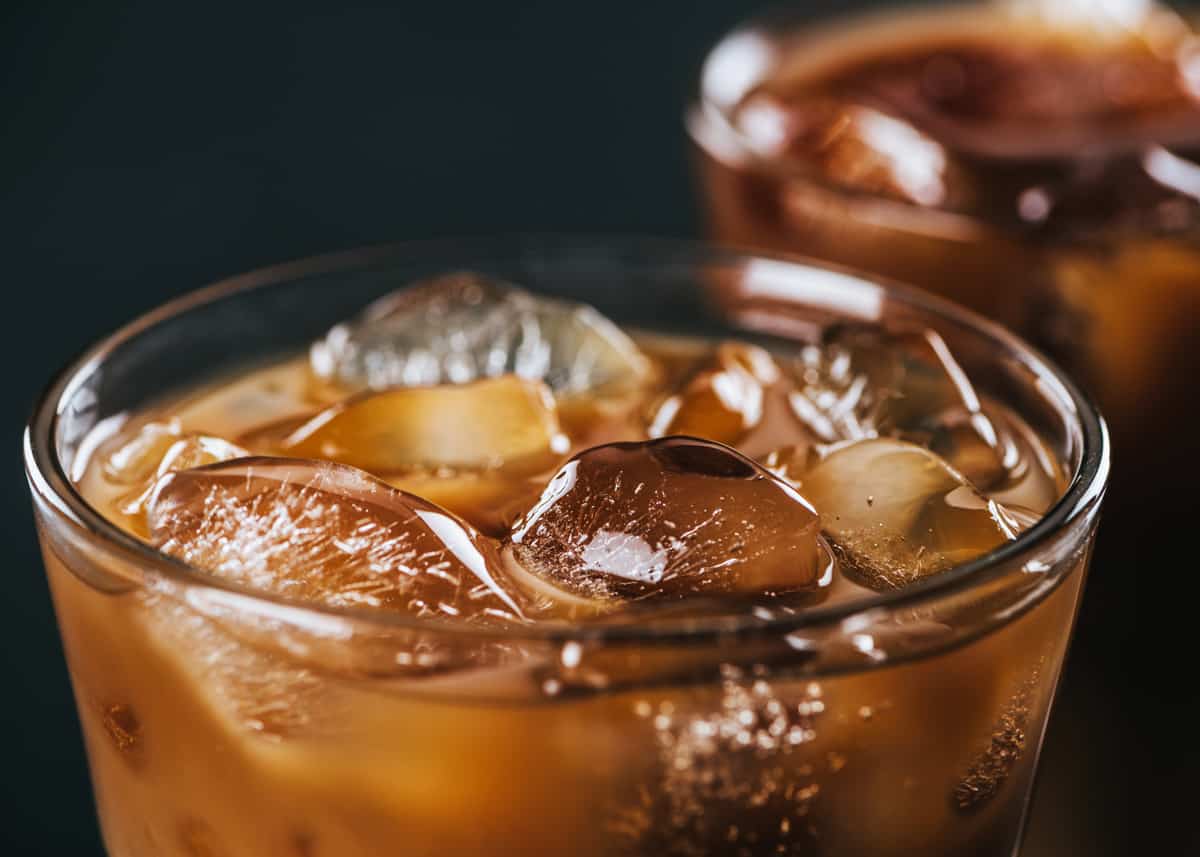
2. How to Make Cold Brew With a French Press
As with other cold brew coffee methods, the French press method is really easy. And it doesn’t take up much room in the fridge.
This is how I make my cold-brew coffee.
French Press Cold Brew Coffee Recipe
How to make cold brew coffee with a French press:
- Measure out your medium to coarse grounds (coarse are better) at a 1:4 or 1:5 coffee-to-water ratio in your French press. For example, 1 cup of ground coffee to 4 cups of filtered cold or room temperature water.
- Stir the coffee in the water making sure they are thoroughly wet.
- Set to brew. Put the cover on the French press (don’t plunge). If you don’t have room for the plunger to be extended you can cover the french press with plastic wrap (or something else to protect it from bugs and flavors/aromas) and set it in the fridge for 12 to 24 hours. Or if you don’t have space in the fridge you can leave it on the counter for between 14-18 hours.
- Plunge. When it’s ready, remove the plastic wrap and plunge as you normally would when making regular French press coffee. See tips below.
- Enjoy! Pour the concentrate into another container, cover it, and store it in the fridge. This cold brew concentrate can be served diluted with water or milk. It’s usually diluted with a one-to-one (1:1) ratio but you can experiment and do what suits you best.
Helpful Tip: If you don’t like sediment in your coffee it may be good to do a second filter when making French press cold brew. I find that after plunging the grounds (even when I use a coarse grind) I have to run the cold brew through a paper filter. I have a Chemex so I just set that up and run the cold brew through the Chemex filter.
The following video will show how to make cold brew coffee at home using a French press. Tap water is used in the video but I recommend filtered water.
3. How to Make Cold Brew with the Toddy System
To make cold brew at home using the Toddy System you’ll need a little more space on your counter or in your fridge than the above two methods.
Toddy System Cold Brew Coffee Recipe
For the following recipe, you’ll need 12 ounces of medium to coarsely ground coffee and 7 cups of water.
How to make cold brew coffee with a Toddy System:
- Place the rubber stopper in the bottom of the brewing container.
- Dampen the filter (only takes a couple of seconds) so it’s damp on both sides.
- Place the filter inside the brewing container above the recessed area where the rubber stopper goes.
- Add one cup (8 ounces) of filtered room-temperature water to the Toddy brewing container.
- Add 6 ounces of medium to coarse grounds.
- Add 3 more cups of water, pouring in a circular motion.
- Submerge the floating grounds without stirring.
- Let sit for about 5 minutes.
- Add 3 more cups of water
- Add 6 more ounces of medium to coarse grounds.
- Submerge the floating grounds without stirring.
- Cover the brewing container and allow the coffee to steep in the fridge for 12 to 24 hours. Or if you don’t have space in the fridge you can leave it on the counter for between 14-18 hours.
- When it’s ready, hold the brewing container above the glass pitcher and remove the rubber stopper. You can set the brewing container on top of the glass decanter and allow it to drain.
- Discard the grounds and place the airtight lid on the glass decanter, place it in the fridge.
- With this ratio, it’s suggested to dilute the concentrate 1:3 cold brew to water.
Helpful tips: When putting your coffee and water in the brewing container try not to stir the ground coffee, but gently press what’s floating under the water’s surface. Stirring can clog the Toddy System.
Using room temperature water may help the ground coffee be easier to work with. Cold water may make the coffee float more.
Using paper filter bags can make this process even easier.
Here’s a video of how to use the Toddy System that might help as you make this cold brew coffee at home:
The above instructions are measured for this size Toddy Cold Brew System. It comes with the brewing container, rubber stopper, 2 reusable filters, and the glass decanter with lid…
This Toddy System makes more coffee than the other two cold brew methods mentioned above so it might be a good option for larger families or an office.
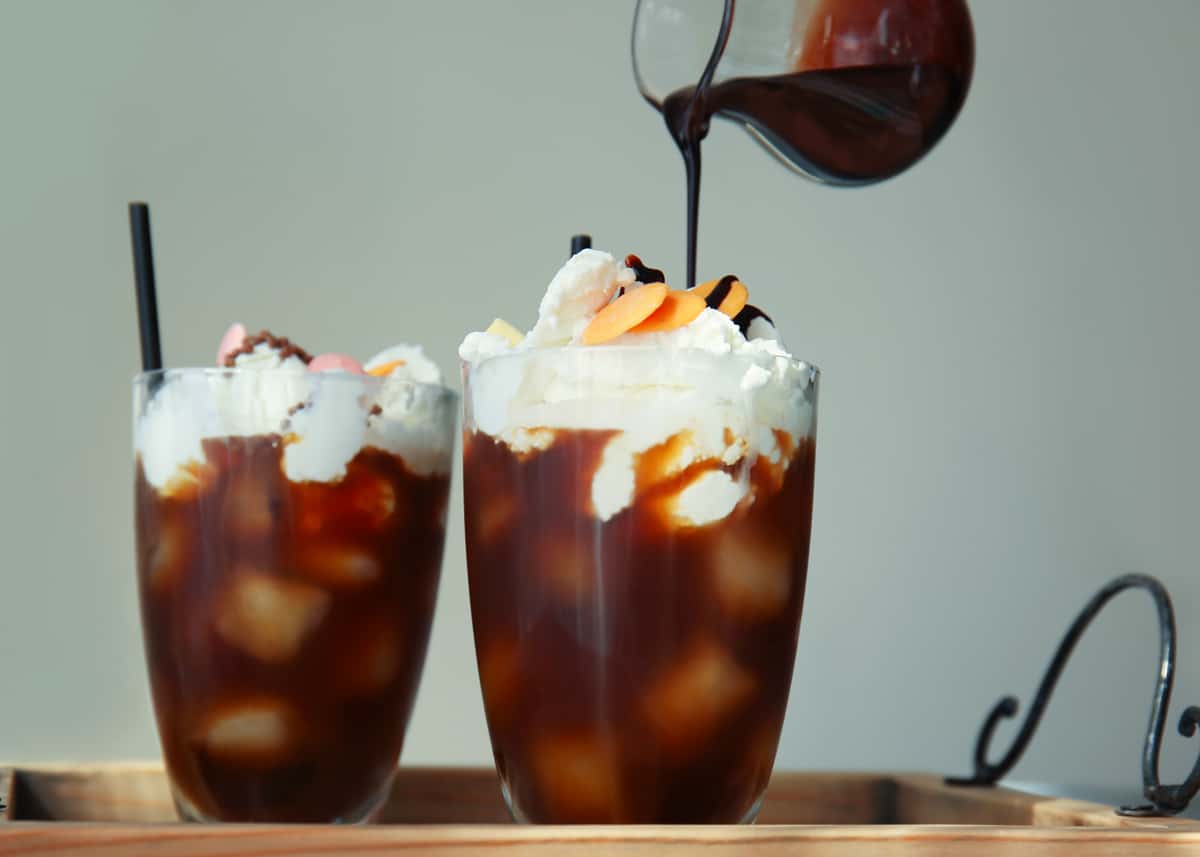
6 Tips for Better Tasting Cold Brew Coffee
Have you tried making cold brew coffee at home and thought it should have tasted a little better? That’s understandable.
Coffee is about personal preferences and experimentation. Many people like cold brew black, but you may not be one of them – especially if you don’t usually drink your coffee black.
Here are a few things you could try that may improve the flavor of your cold brew:
- Try using a different roast. For example, if you used a dark roast try a light or medium.
- Try beans from a different area. Beans from higher elevations tend to have fruitier flavor notes. Try a coffee grown in high elevations (like Ethiopian or Columbian beans). Arabica beans grown between 4000 to 6000 feet will often have sweet flavor notes of fruit and chocolate.
- Brew it in a different location. If you brewed it in the fridge try brewing it on the counter. Or vice-versa.
- Chang up your grounds-to-water ratio. You could try out a different ratio, some people prefer a higher grounds-to-water ratio when steeping their coffee. I like a 1:4 ratio, but you might like it stronger, like a 1:3 ratio for example. Or you might like it less strong, a 1:7 or 1:8 ratio. And make sure to use filtered water.
- Try changing the way you dilute it upon serving. You could dilute it with more or less water before you serve it. Or try diluting it with milk rather than water.
- Get fancy. You could add some maple syrup, cinnamon, whipped cream, coconut milk, vanilla ice cream, and other delightful things.
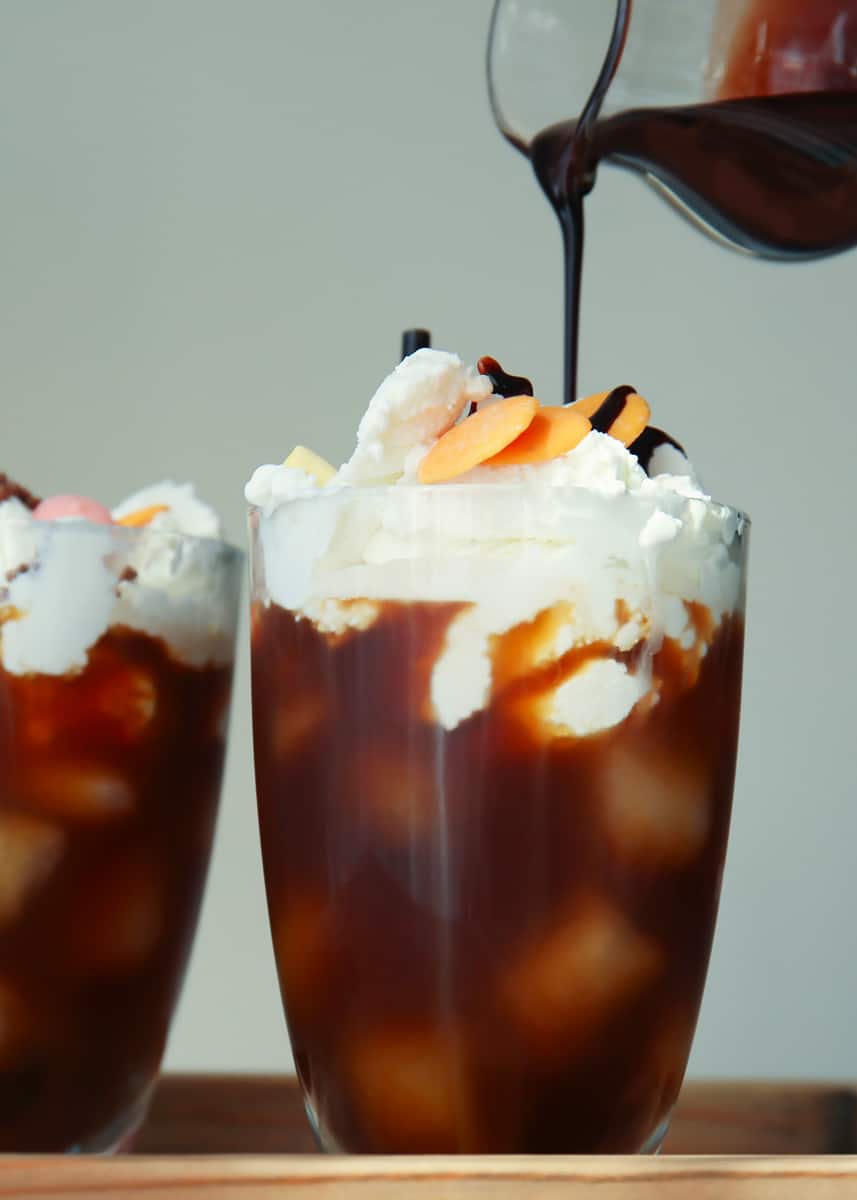
Best Coffee for Cold Brew
The best kind of coffee for cold brew would be an arabica coffee grown at around 4000 to 6000 feet above sea level. Arabica coffee has pleasant flavor notes including chocolate, nuts, and caramel, unlike robusta coffee which has harsher more bitter flavors.
In my opinion, it’s always best to use organic coffee if you can. The less garbage on your beans the better. And using it as close to the roast date as possible is never a bad idea.
Freshly ground coffee would also be a safe bet for producing a great-tasting cold brew.
Type of Roast: When it comes to the roast (light, medium, or dark) that really depends on your flavor preferences.
If you like a fruitier flavor go with a lighter roast arabica. If you’re looking for a more chocolatey/nutty stronger flavor try a medium to darker roast arabica. Make sure to look at the flavor notes mentioned on the bag, it will help you get the type of cold brew you’re after.
As I mentioned above a freshly roasted freshly ground coffee will be better, but when it comes to cold brew that’s not as big of a deal as it is with beans used for a hot brew.
Because cold brew steeps for such a long time and uses cold water you can still get a good brew with beans that are getting a little past their prime.
If you’ve got a few favorite brands of coffee that you’re just loving as a regular hot brew, chances are you’re going to want to start with them when making your cold brew. It would be a safe place to start.
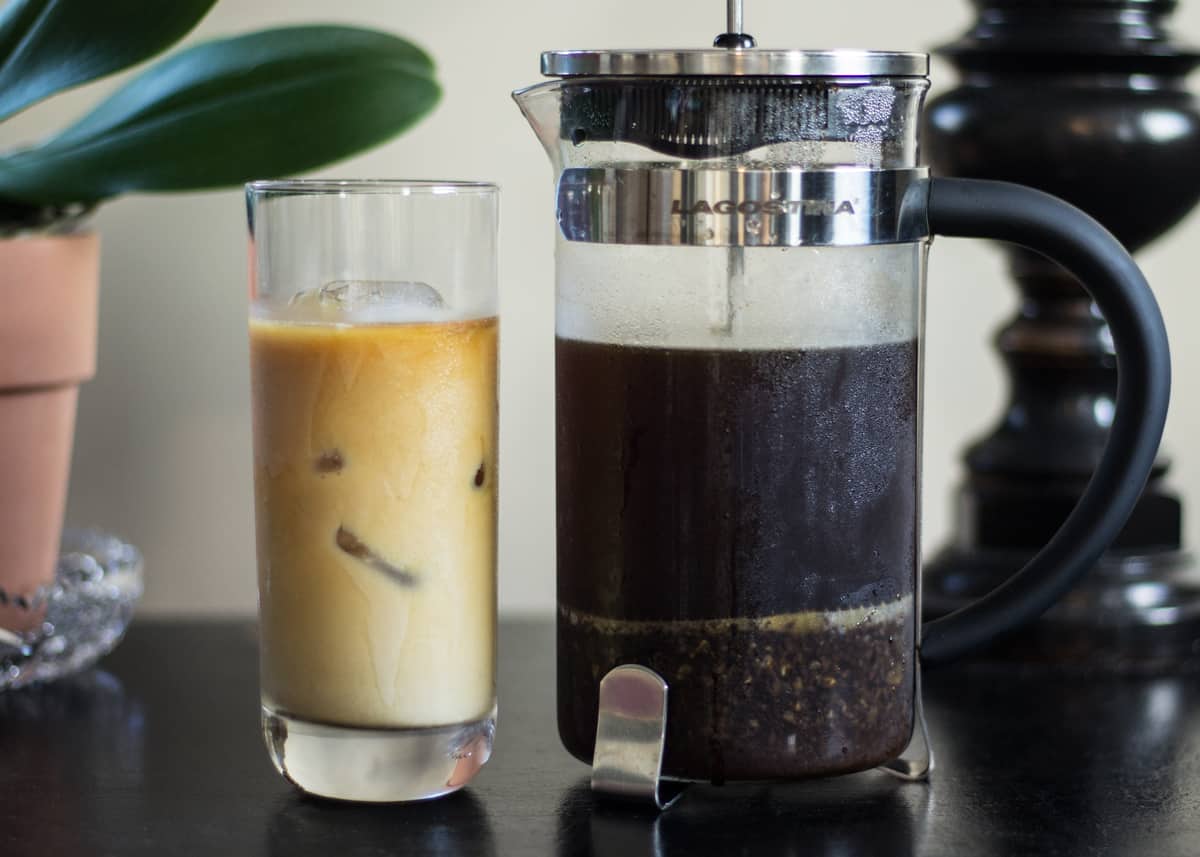
How Will You Make Your Cold Brew Coffee?
Now that you know three easy ways to make cold brew coffee at home, how will you make yours?
I usually make mine with my French press and I steep it in the fridge for around 18-20 hours.
The French press is easy and doesn’t take up too much space. I like to add some filtered water, ice, and a little cream when I drink it. But in the winter I start the morning by adding hot water to my cold brew.
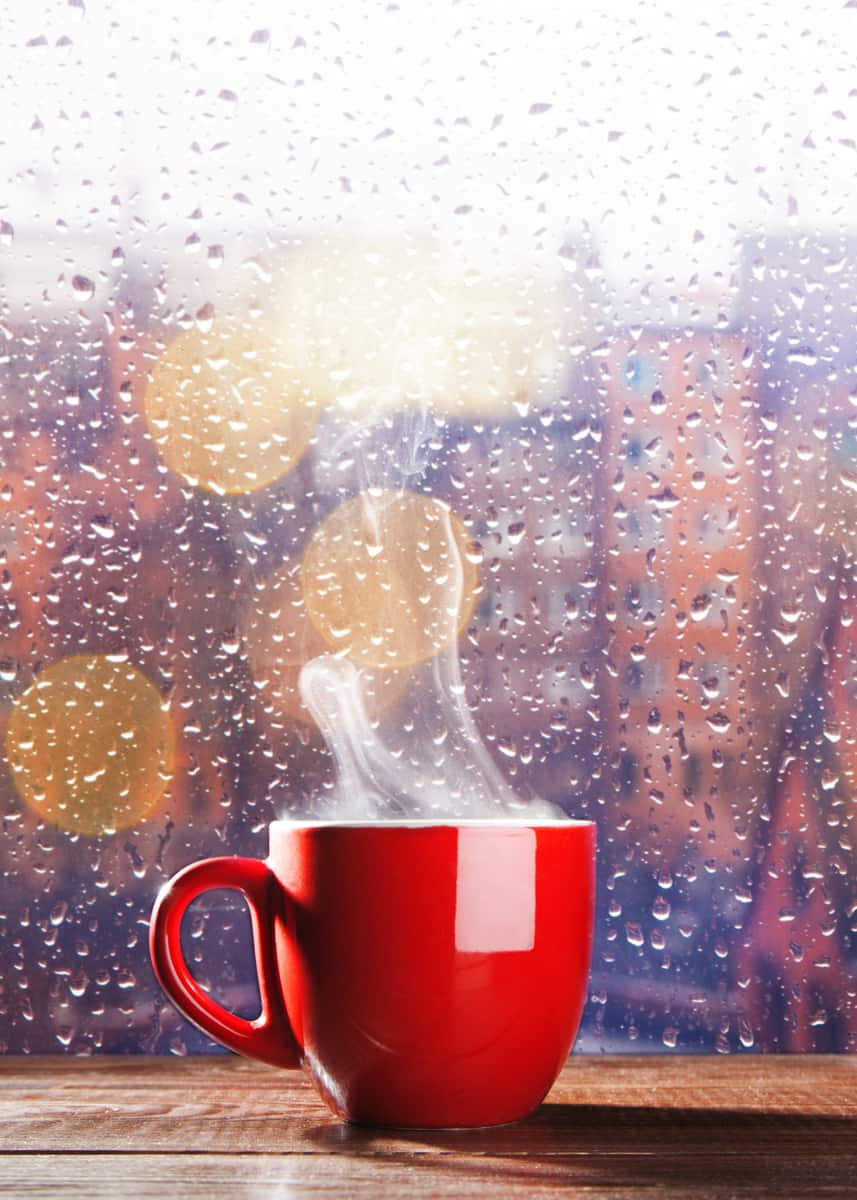
If you have any cold brew coffee tips please share by commenting on this post. And if I’ve left anything out please let me know.
- About the Author
- Latest Posts
Dena Haines is a co-founder and blogger on EnjoyJava – and is working to make it the best coffee blog in the world.
She also blogs about travel at Storyteller.Travel and photography at Storyteller Tech. Dena is a partner at Storyteller Media, a publishing company she started with her husband, Bryan.



Gary
Friday 21st of October 2022
The best explanation and how to thanks.
Leslie
Monday 29th of August 2022
Sweet & condensed milk!! Yumm!
kean
Friday 1st of April 2022
the 1:4 ratio, how many ml of concentrated coffee it is?
Joanna
Thursday 9th of September 2021
When you were talking about the grounds to water ratio, were you referring to the finely ground beans that you buy from the store or more of coarser grounds?
Cindy
Monday 2nd of August 2021
How much coffee grounds do you use for a single serving (12 oz.) Cup of cold brew?